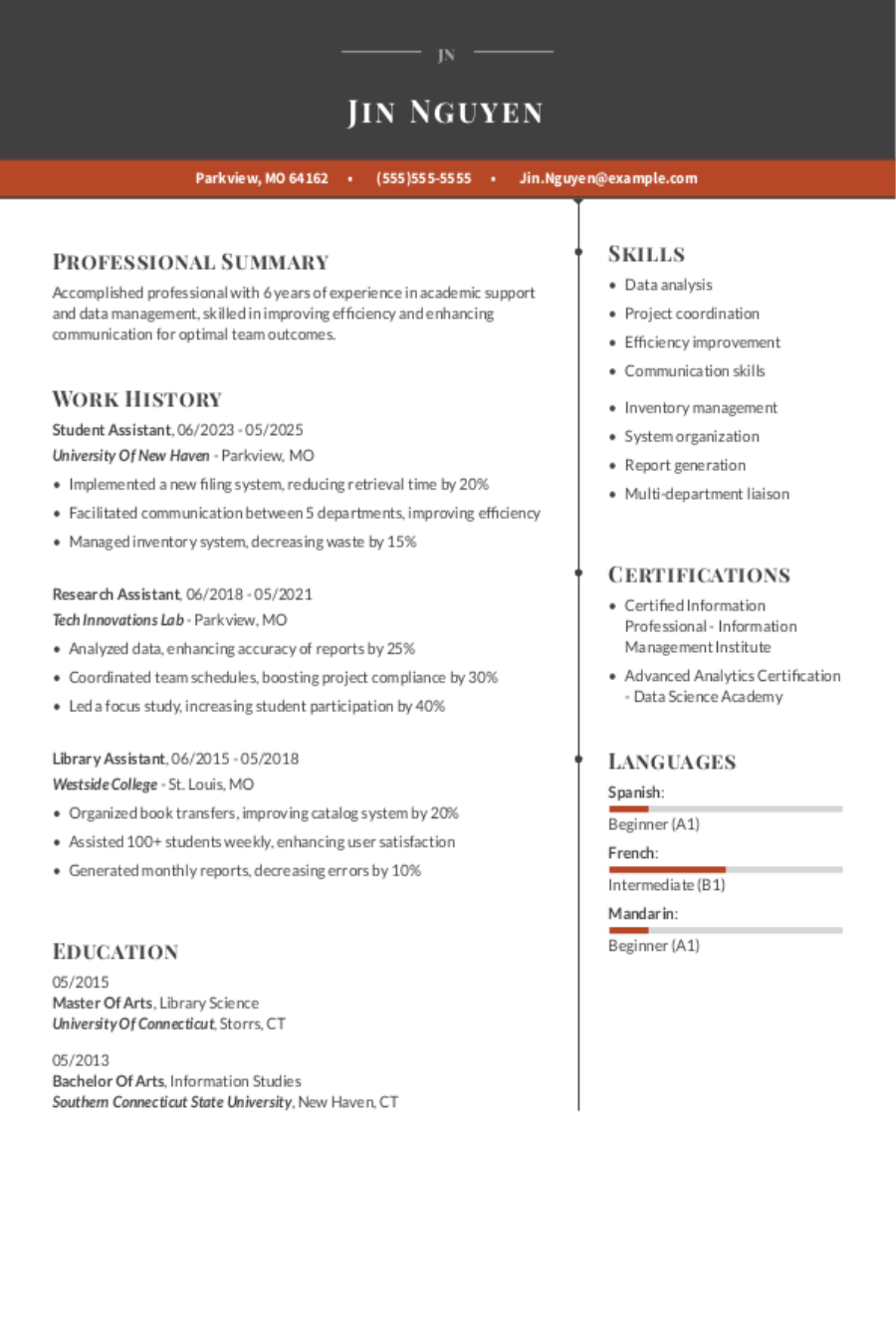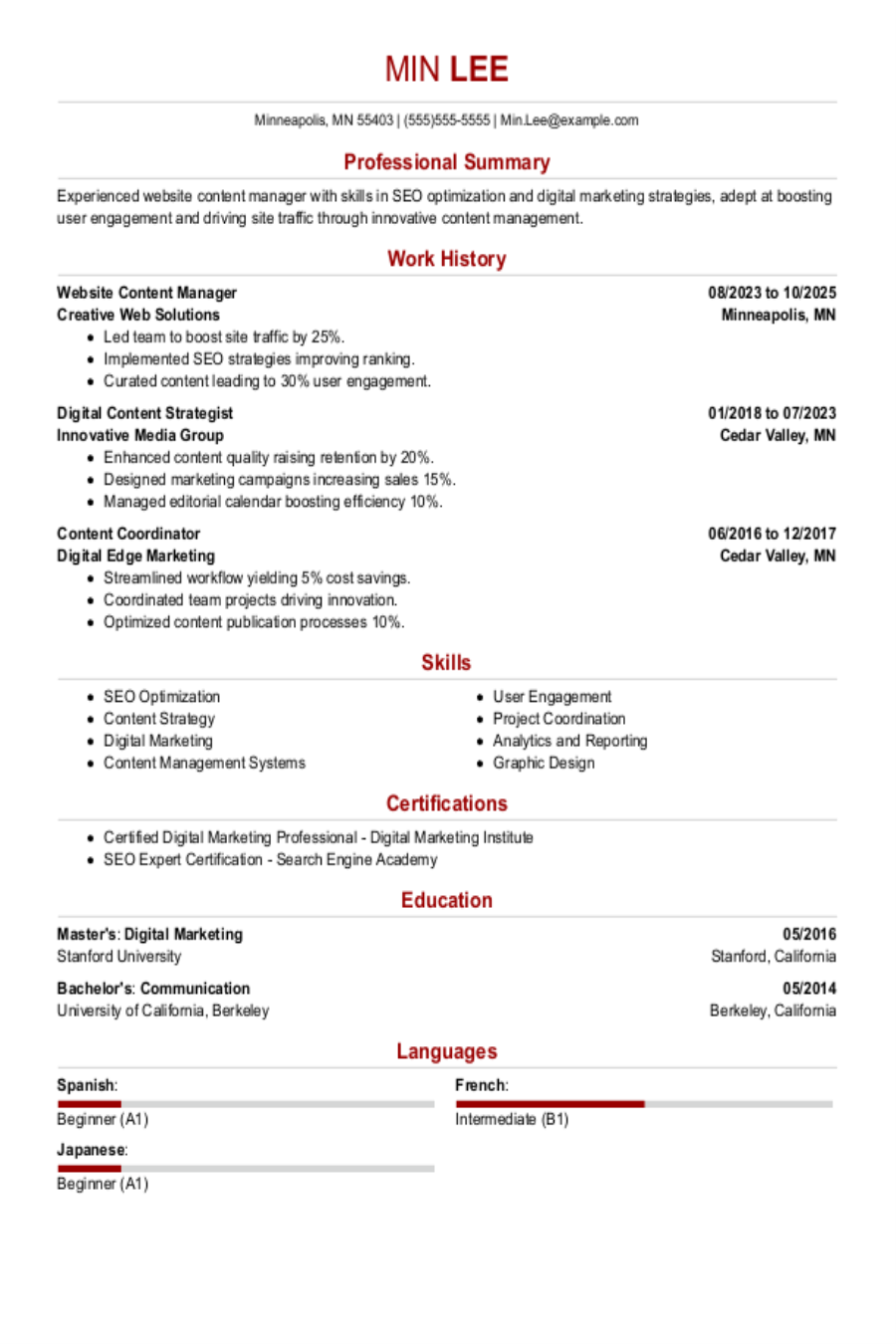Popular Product Owner Resume Examples
Entry-level product owner resume
An entry-level resume for a product owner should highlight relevant coursework, agile methodologies, project management skills, and certifications that show preparedness for the role even with limited experience.
Showcases education: This resume builds the candidate’s credibility by placing a strong focus on their educational background.
Emphasizes soft skills: This resume highlights the applicant's strong soft skills in leadership and stakeholder engagement, effectively offsetting their limited experience.
Mid-career product owner resume
A mid-career product owner resume should emphasize a strategic mix of project experience, agile methodologies, and leadership skills that demonstrate your growth and value to potential employers.
Begins with a powerful summary: This resume's professional summary highlights the job seeker's extensive background and achievements in product ownership.
Employs active language: Using action verbs such as "increased," "led," and "defined" illustrates the proactive approach and significant achievements in driving product success.
Experienced product owner resume
An experienced product owner resume should emphasize the applicant's successful project management experiences and ability to drive product vision while highlighting measurable results and professional growth over time.
Optimized for ATS: The resume uses a polished template that features a professional header and an ATS-friendly resume layout, ensuring clarity for both human recruiters and automated systems during the screening process.
Follows traditional format: Using the chronological resume format effectively illustrates the extensive experience of the job seeker, making it simple for readers to follow their career advancement and contributions across various roles in product development.
No experience product owner resume
A resume for an applicant with no experience should highlight transferable skills, relevant coursework, and any leadership roles in projects to showcase the job seeker's potential for success in the position.
Uses a simple style: The resume's clean and straightforward layout effectively highlights key achievements and relevant skills, making the job seeker's qualifications stand out without unnecessary clutter.
Avoids jargon: Job seekers often feel pressured to embellish their experiences with complex jargon or elaborate descriptions of basic tasks. However, this resume's straightforward and honest approach is far more powerful, as it clearly demonstrates their capabilities.
More resume examples
Additional Guides
- Art
- Artist
- Banking
- Biotech
- Budtender
- Business
- Business Operations
- Cashier
- Chef
- Chemistry
- College
- Communications
- Computer
- Computer Science
- Construction
- Consultant
- Cook
- Customer Service
- Customer Success Manager
- Cyber Security
- Dentistry
- Driving
- ECommerce
- Engineering
- Entry Level
- Esthetician
- Executive
- Federal
- Firefighter
- Food Service
- Government
- Graduate
- Graphic Designer
- Handyman
- Healthcare Support
- High School Student
- Hospitality
- Human Resources
- Industrial Engineering
- Insurance
- Interior Design
- Internship
- IT
- Law
- Manager
- Marketing
- Medical
- Military
- Music
- Nursing
- Performing Arts
- Pharmacy Technician
- Photographer
- Physical Therapy
- Pilot
- Product Manager
- Production Assistant
- Program Manager
- Project Manager
- Psychology
- Radiologic Technologist
- Real Estate
- Restaurant Manager
- Retail
- Sales
- Sales Associate
- Scholarship
- Server
- Skilled Trades
- Social Services
- Software Engineer
- Stay At Home Mom
- Student
- Supervisor
- Teacher
- Teen
- Training Development
- Ux Designer
- Virtual Assistant
- Waitress
Product Owner Resume Template
Looking to create a standout application? Use this product owner resume template as your foundation—simply copy it and personalize it with your own details.
Daniel Garcia
Minneapolis, MN 55408
(555)555-5555
Daniel.Garcia@example.com
Professional Summary
Dynamic product owner with expertise in agile methodologies, successfully led teams to increase product adoption by 35%. Skilled in stakeholder engagement and data-driven decision making to enhance market success.
Work History
Product Owner
Innovative Tech Solutions - Minneapolis, MN
October 2021 - October 2025
- Increased product adoption by 35%
- Led agile teams to deliver 3 successful products
- Reduced costs by 20% through efficient resource management
Scrum Master
Agility Hub Inc. - Minneapolis, MN
July 2018 - September 2021
- Facilitated 40+ scrum meetings
- Streamlined all processes for a 25% efficiency boost
- Managed cross-functional team of 10 members
Project Coordinator
Synergy Works LLC - Minneapolis, MN
October 2016 - June 2018
- Coordinated project milestones with a 90% success rate
- Optimized project timelines by 15%
- Implemented tracking tools improving issue resolution times
Skills
- Agile Methodologies
- Product Lifecycle Management
- Stakeholder Engagement
- Data-Driven Decision Making
- Roadmap Planning
- Team Leadership
- Cross-Functional Collaboration
- Market Analysis
Certifications
- Certified Scrum Product Owner (CSPO) - Scrum Alliance
- Project Management Professional - Project Management Institute
Education
Master of Business Administration Product Management
Stanford University Stanford, California
June 2016
Bachelor of Science Computer Science
University of California, Berkeley Berkeley, California
June 2014
Languages
- Spanish - Beginner (A1)
- French - Beginner (A1)
- Mandarin - Intermediate (B1)
Must-Have Skills on a Product Owner Resume
A strong skills section is important for any effective resume.
The following data highlights the most sought-after hard and soft skills tailored for a product owner role, based on insights from our internal resume database.
When you’re ready to improve your resume with essential skills, try using our AI Resume Skills Generator. This tool can recommend both hard and soft skills aligned with your specific job title, allowing you to create a comprehensive and individualized skill set.
Writing Your Product Owner Resume
Now that you've explored these excellent product owner resume examples, it's time to dive into the detailed process of how to write a resume. We’ll provide you with a step-by-step guide, breaking down each section for clarity and effectiveness.
List your most relevant skills
An effective skills section on your product owner resume should highlight both technical abilities, like agile project management and user story development, as well as essential soft skills such as collaboration and stakeholder communication.
To improve your chances of getting noticed, carefully examine job listings for this position and incorporate relevant keywords from the job listing. By using terms like "backlog grooming" or "requirements gathering," you signal to human recruiters that you understand what they need. Additionally, this strategy helps you pass through applicant tracking systems, ensuring that your resume lands in front of decision-makers.
Example of skills on a product owner resume
- Proficient in gathering and analyzing user feedback to inform product development
- Skilled in creating detailed product roadmaps and prioritizing features
- Strong communicator with the ability to collaborate across departments
- Adaptable thinker focused on delivering high-quality user experiences
Highlighting your soft skills on your resume can set you apart from other applicants. Employers appreciate interpersonal abilities since they are often challenging to develop, and showcasing them can demonstrate your potential for teamwork and collaboration.
Highlight your work history
The work experience section of your product owner resume should highlight your achievements in each role. By showcasing how you successfully drove product development and collaboration within teams, you can illustrate the impact of your expertise.
When detailing each job entry, include key information: your job title, the employer's name, and the employment dates. This basic structure allows hiring managers to quickly assess your background and experience level. Make sure to focus on specific accomplishments that showcase how you contributed to projects or improved processes.
Example of a product owner work experience entry
- Product Owner
Innovative Solutions Inc. - San Francisco, CA
March 2019 - Present - Lead a cross-functional team of 10 to deliver high-quality software products on time and within budget, achieving a 30% increase in project efficiency
- Develop and prioritize product backlog items based on stakeholder feedback, market research, and business objectives, resulting in a 25% faster feature rollout
- Facilitate agile ceremonies including sprint planning, reviews, and retrospectives to ensure continuous improvement and team alignment with project goals
- Collaborate closely with UX/UI designers to improve user experience based on analytics, increasing user engagement by 40%
- Mentor junior product owners and interns in agile methodologies and best practices, fostering a culture of learning and growth within the team
Aim for clarity in your bullet points. Each entry should highlight a specific achievement without unnecessary fluff. Focus on results and impact to keep your resume concise yet informative.
Include your education
The education section of your product owner resume should present your academic achievements in reverse-chronological order, starting with the most recent degree. Include your diplomas and degrees while omitting your high school diploma if you have attained a bachelor's degree or higher. It is also beneficial to highlight any relevant coursework or honors that demonstrate your expertise in product management.
If you are currently pursuing further education or if your educational background is incomplete, indicate the highest level achieved along with an expected graduation date. For those still studying, including bullet points that highlight relevant courses and significant projects can be helpful as it showcases relevant skills to potential employers.
Common certifications for a product owner resume
- Certified Scrum Product Owner (CSPO) – Scrum Alliance
- Professional Scrum Product Owner (PSPO) – Scrum.org
- SAFe Product Owner/Product Manager (POPM) – Scaled Agile, Inc.
- Agile Certified Product Manager and Product Owner (ACPMPO) – 280 Group
Sum up your resume with an introduction
An effective profile section is important because it creates a strong first impression on potential employers. It serves as your introduction, summarizing who you are and what you bring to the table.
For experienced job seekers, a professional summary is the ideal choice. This format allows you to showcase specific accomplishments and skills that align with the job description. If you have little experience, create a resume objective centered on your professional development goals.
Professional summary example
Dynamic product owner with over 8 years of expertise in agile environments. Successfully led cross-functional teams to deliver innovative solutions, improving user engagement and driving product growth. Expert in backlog management, stakeholder communication, and iterative development processes.
Resume objective example
Enthusiastic product owner eager to apply a solid understanding of Agile methodologies and user-centered design to improve product development in a collaborative environment. Committed to using strong communication and analytical skills to drive project success and deliver exceptional value to customers.
As a product owner, it's important to keep your resume profile concise yet packed with key information. Aim for three sentences that emphasize your most relevant skills and experiences. You can expand on additional details in your cover letter instead.
Add unique sections to set you apart
Improve your resume by adding optional sections that highlight your distinct qualifications for product owner roles. These sections allow you to present a fuller picture of who you are as a applicant.
Including details about relevant hobbies or volunteer experiences can give employers insight into your values and skills. For instance, if you've volunteered for tech-related events or led community projects, it shows your commitment to collaboration and innovation. Such information not only humanizes your application but also illustrates how you apply your skills outside of work, making you a more attractive prospect in the eyes of potential employers.
Three sections perfect for a product owner resume
- Languages: As a product owner, effective communication with stakeholders is essential. Highlight your language skills on your resume to improve collaboration and ensure clear understanding across diverse teams.
- Volunteer Work: Including volunteer work on a resume not only improves your skills but also demonstrates your dedication to making a positive impact. It showcases your commitment and passion for helping others, which can resonate with potential employers.
- Accomplishments: As a product owner, quantifiable accomplishments are important for showcasing your impact on project success. Incorporate these achievements into your experience section, or highlight them separately under accomplishments.
5 Resume Formatting Tips
- Choose a format that matches your career stage.
Choosing the right resume format is important for showcasing your qualifications. If you have significant experience, a chronological resume highlights your career progression effectively. For those with limited experience, a functional resume emphasizes skills over job history. A combination format works well if you want to highlight both your experience and relevant skills.
- Pick a smart resume template.
Using a professional resume template can significantly improve the readability of your application. Choosing a well-structured format helps hiring managers swiftly understand your qualifications. If you prefer custom formatting, be sure it remains clean and uses ATS-friendly fonts for better compatibility with applicant tracking systems.
- Select an appropriate font.
To improve your resume's readability, opt for a professional font. Fonts like Helvetica, Garamond, or Verdana will ensure your document looks polished and is easy to read for both ATS and hiring managers.
- Use consistent formatting.
Ensure your resume is neatly formatted with uniform margins on all sides. This attention to detail improves readability and creates a polished, professional look.
- Keep your resume to one or two pages.
When crafting your resume, remember that resumes should be one page long unless you have extensive experience. Concentrate on making your content concise and relevant to highlight the most important information about your skills and achievements.
Tools for Your Job Search
Are you gearing up to apply for that sought-after product owner position? Before hitting send on your application, make sure to use our ATS Resume Checker. This tool offers insights into how your resume measures up against the automated systems many companies use for screening applicants.
Looking to take your resume to the next level? Our AI Resume Builder delivers personalized content suggestions tailored specifically to your product ownership experience. It also includes professional templates designed to showcase your skills and achievements effectively.
Frequently Asked Questions
Last Updated: November 4, 2025
Absolutely. A cover letter is important as it adds valuable context to your resume and fosters communication opportunities with potential employers. It allows you to share your passion for the role and demonstrate how your skills make you an ideal job seeker. Don’t overlook this chance—write a cover letter that truly reflects who you are.
For a quick and effective solution, try our AI Cover Letter Generator, which helps you create personalized cover letters in just minutes. You can also choose from various cover letter template options that perfectly align with your resume, ensuring a polished and professional presentation of your qualifications.
A resume is typically concise, spanning one to two pages, and focuses on your most relevant work experience and skills. In contrast, a CV (curriculum vitae) can extend several pages and offers comprehensive details about your academic background, research contributions, publications, and professional experiences.
You’ll want to use a CV when applying for positions in academia, science, law, or medicine where detailed information is essential. For tailored CV creation, our online CV Maker is the perfect tool! It provides various CV templates suited to different industries and career levels—helping you craft a professional document quickly and efficiently.
When addressing gaps on your resume, be honest about the reasons behind them. Explain what you did during that time, whether it was taking courses, volunteering, or personal projects. This approach shows potential employers your commitment to growth. After you've discussed the gap, redirect focus to your relevant qualifications and experiences that demonstrate why you're a strong applicant for the position.
An active LinkedIn profile is important for a product owner's job search. Leverage LinkedIn to expand your professional network and effectively highlight your unique skills and experiences.
To ace your interview, practice answering typical job interview questions and answers. This preparation not only boosts your confidence but also equips you to tackle any surprises that may come your way.
Was this information helpful? Let us know!
Hailey is a career advice writer dedicated to helping job seekers excel in their careers.
More resources

The Most Dangerous Jobs in America: Some Pay Less Than $40K, Others Top $190K
Resume Now s report reveals the highest and lowest paying dang...

How to Write a Resume: Guide & Examples for 2025
If you re wondering how to write a resume that grabs attenti...

Still in the Game: 9 in 10 Older Workers Are Upskilling to Stay Competitive
The idea that older workers are resistant to change doesn t ho...

Chemistry Resume: Examples, Templates & Tips
Make a chemistry resume that gets interviews. Use our writing ...



